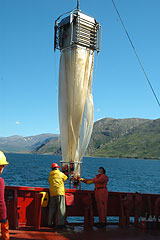

 | ||||||||||
|
|
Journals 2007/2008Caitlin Munroe
August 1, 2007 Location: Saglek Fjord, Shuldham Island We are stopped for several hours here in the Fjord, a group of journalists and a few Parks Canada officials have gone ashore with the captain and chief scientist of the mission, Dave Barber. They are meeting at a seasonal hunting camp with a group of Inuit people from the area. The whole group will return to the ship in a few hours and the Inuit folks will be given a tour of the ship and get to see some of the science work being done. This stop is a full station for the scientists on board, this means all tests will be run. Having gotten up before 6am, I have already filtered the water samples from last night, and am free for a time. This means I have the opportunity to see some of the other science taking place, most specifically the Hydrobios nets and the box core sampling. I'll be back with an update soon. Here again. Louis Letourneau told me about the Hydrobios nets which sample at different levels in the water column. He and Josee Michaud are looking for fish larvae and the copepods they feed upon. Their main focus area on this voyage will be in Hudson's Bay, but they are testing in all three of the fjords as well. These tests have been run in this fjord annually since 2002 and are meant to inform the scientists at exactly which levels the larvae and copepods are found. The Torngat National Park begins just to the North of our location, and Parks Canada is interested in monitoring the health of the fjord, so Josee and Louis are assisting other scientists aboard the Amundsen with one piece of the overall picture. Josee is also collecting samples for scientists at Woods Hole who are interested in the genetics of these tiny arctic creatures (copepods and fish larvae). After samples are collected taxonomy and abundance are the next step, identifying and counting. Josee then takes subsamples and freezes them for later analysis. The hope is that they will be able to link variations in the types and abundances found to environmental factors such as temperature, salinity, and current.
|
|||||||||

